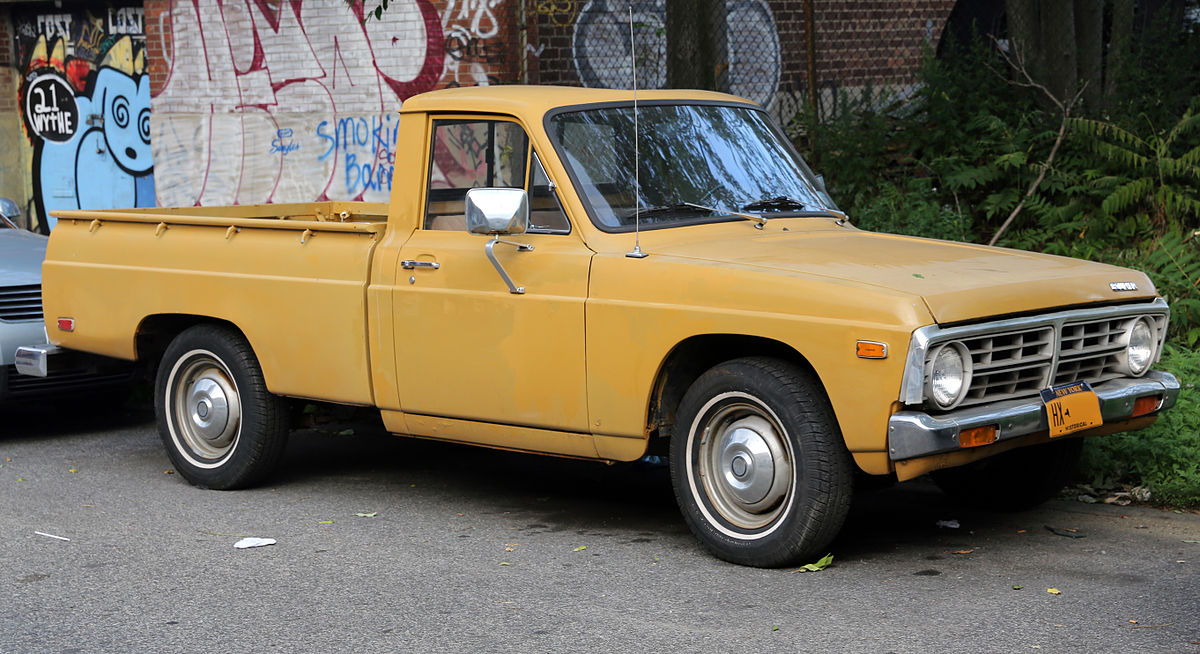In a recent market survey undertaken by members of my immediate family, I discovered that not all aesthetic values are genetically inherited. Rather than being sad, this insight has given me the opportunity to explore new vistas. If people are not interested in revisiting sardine roles, sitting in a mini-van for days or weeks at a time, meditating on the spruce trees of Northern Sweden, I too can abandon the mini-van, and opt for something that reflects my new essence – the workshop activist.
So it is going to be, Au revoir, Berlingo! Hi, Bison! (or if I follow up what I wrote a few weeks ago, Hallo, StreetScooter Work!)
I have had relationships with pickups before. The very first vehicle I drove, in the very early 1960s, aged about twelve, was a Chevrolet Pickup belonging to Harry Raymer, in some fields in Okanagan Mission, near Kelowna, British Columbia, Canada. Later, in the early 1970s, I drove Ernie Jickles – whose eyesight was failing and was not allowed to drive – around in his wife’s Ford Courier pickup, so we could photograph. The Courier was a rebadged Mazda B-1800. In the late 1980s, in Inderøy, I drove a Nissan pickup working on a lafted house project out in Malm.

Forget the past. Today’s story is set in the future, about the Bison, a Dutch-Canadian electric pickup. The primary characteristic it attempts to portray is rugged durability. That’s almost how I describe myself, as do about 90% of the adult male population.
I’m not sure if it is a corporate, or a product motto, but LEADING THE CHARGE™ has both electrical, and military connotations. It also describes itself in terms of three other characteristics: power, precision, strength.
Characteristics of the Bison pickup, I think I understand:
1300 liters of exterior cargo space and 510 liters of lockable storage. Safest truck with carbon fibre reinforced steel space frame. Full electric AWD built for severe weather conditions. High-current power socket for all your tools. Advanced vehicle intelligence and connectivity. Zero emission driving and zero pollution. Dual-motor electric powertrain. Advanced telemetry.
Characteristics, I know nothing about:
Rugged off-road capabilities with 54% hill start and 21% hill climb. I guess this is important, because I live on a hill, but have no idea what it means beyond being able to start off on a hill. Yes, I am too lazy to google it.
Somewhere in between: Class-leading torsional stiffness for enhanced durability and handling. I know what stiffness is, but I thought one invested in a suspension system in trucks to softened up that stiffness.
I would like a person, or even a designer, to read the following paragraph, and tell me that it actually means something that I can use to impress friends: “The Bison speaks a bold design language, punctuated with angular cladding and wedge profiles. An evolutionary leap forward from traditional pickups, the Bison delivers a more modern and provocative approach. With short overhangs and tires pushed to the corners, the stance conveys stability and confidence allowing for aggressive approach and departure angles.”
Included for your visual enjoyment are photographs from the Bison website: http://www.havelaarcanada.com/bison/





I hope you enjoy the Bison. Looks great… I’m curious about all the features, how well they work and how useful they are for you.
The enhanced torsional stiffness is the performance of the body structure as it ‘twists’. Higher stiffness reduces this twist effect and helps the durability through reduced motion and vibration of the body and attached components… and leads to a better ride. And yes, you do need your suspension to soften up (or manage) how that stiffness feels when your driving.
I can explain the words in your paragraph about design language- but I’m not sure I can tell you something that will impress your friends… unless they are ramp / curb enthusiasts!
Finally, do you know the difference between a buffalo and a bison?
(**Bad joke warning**)
Happy trucking!
Thank you for your comment, John. I haven’t gotten to actually buying a Bison yet. Living in Norway, there are a lot of EVs. For the full year 2017, BEVs and PHEVs captured 39.2 percent of the Norwegian market – up from 29.1 percent in 2016. I have not yet seen a BEV pickup! In Germany, the StreetScooter Work is available as a pickup. However, I have yet to see one in Norway.
Thank you as well for your insights regarding torsional stiffness.
Regarding the difference between a bison and a buffalo, https://www.livescience.com/32115-bison-vs-buffalo-whats-the-difference.html offers the following explanation: “Burly, shaggy bison (Bison bison), the North American hoofed mammals that, for many people, embody the American West, are often referred to as buffalo.
But even though they are in the same family group as Old World buffalo species — the Asian water buffalo (Bubalus bubalis) and the African cape buffalo (Syncerus caffer) — bison are not closely related to those species, making the common name “buffalo” misleading.”
Hope you are having an enjoyable May!
Brock
Thanks for your kind reply Brock!
The (somewhat poor?) joke in our house goes…
Q: What’s the difference between a buffalo and a bison?
A (in your best English accent): You can’t wash your hands in a buffalo!
I’ve never shared this joke in writing before – but I hope it still passes muster!
Cheers!
John
That is the sort of humour that is appreciated, John. Thanks for sharing!
Brock